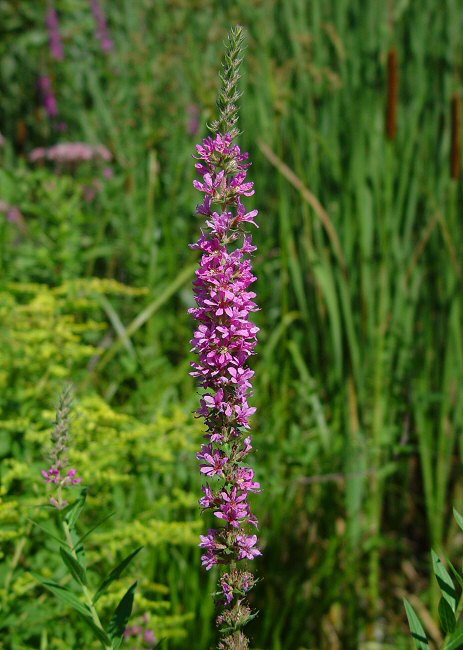Lythrum salicaria L.
Purple Loosestrife

Introduced
CC = *
CW = -5
MOC = 22
© SRTurner
Lythrum salicaria L.Purple Loosestrife | |
 |
Introduced CC = * CW = -5 MOC = 22 |
© SRTurner |
|
Family - Lythraceae Habit - Perennial forb with fibrous roots and rhizomes, often colonial. Plants moderately to densely pubescent with short, stiff, relatively broad-based, tapered, unbranched hairs, sometimes roughened to the touch, the lower portions of the stem sometimes becoming nearly glabrous with age. Stems - Erect with ascending branches, to 2.5 m, multiple from base, wandlike, usually more or less ridged, but not winged.
Leaves - Opposite, simple, sessile or nearly so. Leaf blades 1-10 cm long, narrowly to broadly lanceolate, the upper leaves sometimes nearly linear, truncate to shallowly cordate or rarely broadly rounded at the base, mostly sharply pointed at the tip, entire, greatly reduced in inflorescence to foliaceous bracts.
Inflorescence - Elongate, bracteose spikes or panicles with spicate branches, the leaves reduced fairly abruptly into the leaflike bracts, with a pair of small clusters of usually 3 flowers each at the nodes, the individual flowers sessile or with a minute stalk to 1 mm, usually subtended by a pair of inconspicuous, linear bractlets, these shed early. Axis of inflorescence densely pubescent to tomentose.
Flowers - Actinomorphic or nearly so, the hypanthium cylindrical, symmetric at the base, not or only slightly oblique at the tip, the hypanthium plus sepals 3-7 mm long, with 8-12 longitudinal ridges. Sepals 6, triangular to broadly triangular, more or less ascending, the appendages about twice as long as the sepals, thickened, narrowly conic-triangular, arched outward. Petals usually 6, 7-12 mm long, reddish pink to purple, sometimes somewhat disheveled, but not appearing ruffled or crinkled. Stamens usually 12, in two sets of five or six each, those of different flowers with filaments of potentially 3 different lengths (those of an individual flower of 1 or 2 lengths), the anthers exserted or not, yellow. Pistils lacking a nectary disc, the ovary cylindrical-conic, 2.5 mm long, 1 mm in diameter, 2-locular, the styles of potentially 3 different lengths in different flowers, exserted or not. Stigma glandular, capitate, green.
Flowering - June - September. Habitat - Riverbanks, pond margins, sloughs, marshes, fens, bottomland forests, ditches, roadsides, wet disturbed areas. Also cultivated. Origin - Native to Europe. Lookalikes - L. alatum. Other info. - This plant has a reputation as a seriously noxious invasive of wetlands, particularly in the northern half of the U.S. Thus far it has not made major inroads in Missouri, perhaps due to efforts at control and eradication, or because Missouri's climate is less suited to its preferences. However, it should never be deliberately cultivated, and supposedly sterile forms of the plant should also be avoided, as crossing with the wild type can produce viable seed. Generally speaking, outbreaks of the plant should be reported to relevant authorities. It is highly invasive and can quickly spread through an area and out-compete all native flora. It creates a sea of pink which may be pretty to look at but is an environmental disaster. Currently the plant has been reported mostly from counties bordering the Missouri River, along with a few other, widely scattered counties. Care should be taken to distinguish this harmful plant with the native L. alatum, which is a well-behaved and beneficial member of our native flora. That species has foliage which is glabrous and flowers which are usually borne singly in leaf axils, rather than in a dense, bracteate inflorescence. Photographs taken off Hwy 64, somewhere in the U.P. of Michigan, 9-7-03 (DETenaglia); also at Riverfront Park, Washington, Franklin County, MO, 8-23-2014, 7-30-2024, and 7-10-2025 (SRTurner). |